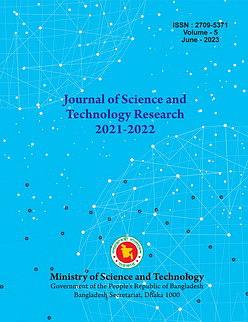Isolation, Identification and Molecular Characterization of Lumpy Skin Disease Virus for Development of Vaccine
DOI:
https://doi.org/10.3329/jscitr.v5i1.74003Keywords:
Cattle, Chicken embryo, PCR, Sequence, Multiple sequence alignmentAbstract
The highly contagious Lumpy skin disease (LSD) virus has been rapidly spreading across South and East Asia, posing a grave threat to cattle populations in the region. LSD initially emerged in Bangladesh during July 2019, starting in the Chattogram district and rapidly spreading across the entire country. To investigate cases of LSD in cattle, a comprehensive study was conducted in various districts of Bangladesh, including Natore, Kurigram, Dinajpur, Dhaka, and Mymensingh. A total of 58 samples comprising blood, skin scraping, buccal swabs, and nasal swabs were collected for analysis. In order to identify LSDV, the DNA was isolated from the processed samples, and a conentional PCR method was employed utilizing the specific primer designed for the 'P-32 Gene' gene. Out of the blood samples tested, only 29.17 percent yielded a positive result for LSDV, whereas a substantial 80 percent of the skin samples tested positive. This suggests that skin scrapings are a viable specimen for LSD diagnosis using PCR. Five positive samples were partially sequenced utilizing the "ANK Gene" for molecular characterization. Bangladeshi isolates have a strong association with LSDV Kenyan (KSGP 0240, NI-2490) strains and Indian isolates (Ranchi, 2019) strains, based on multiple sequence alignment and phylogenetic analysis. Additionally, the sequencing of all the samples from the five research sites were almost identical, suggesting that a single strain is probably spreading throughout the nation. These findings emphasize the need for continuous monitoring of the genetic makeup and molecular epidemiology of LSDV, which will be useful in the future for the development of vaccines specific to the strains that are then in circulation.
J. of Sci. and Tech. Res. 5(1): 31-36, 2023
358
284
Downloads
Published
How to Cite
Issue
Section
License
Copyright (c) 2023 A A Bhuyan, J Alam, J Khanom, N Moonsif, Rubaya, M A Alim, M M Kamal Hossain, N Jahan, M Salimullah

This work is licensed under a Creative Commons Attribution 4.0 International License.




